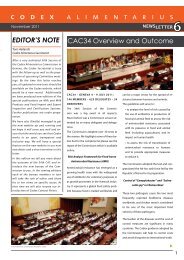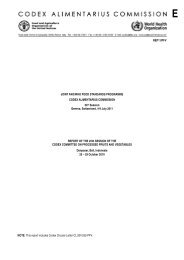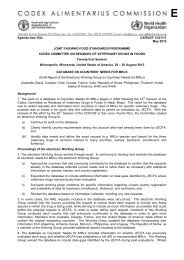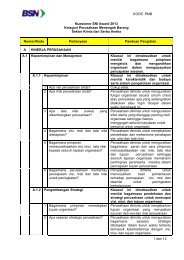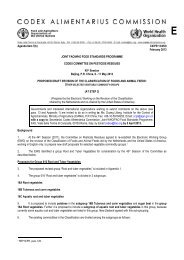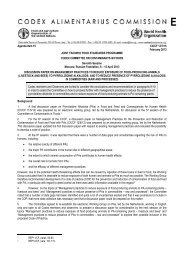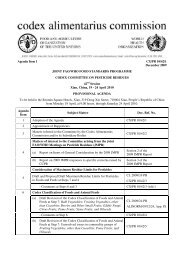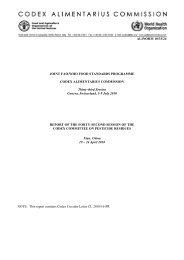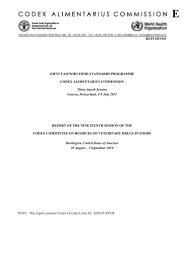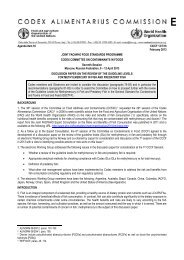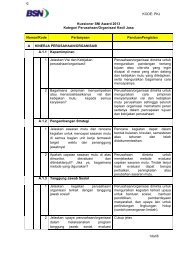alinorm 10/33/41 - CODEX Alimentarius
alinorm 10/33/41 - CODEX Alimentarius
alinorm 10/33/41 - CODEX Alimentarius
Create successful ePaper yourself
Turn your PDF publications into a flip-book with our unique Google optimized e-Paper software.
ALINORM <strong>10</strong>/<strong>33</strong>/<strong>41</strong>58APPENDIX VIPROPOSED DRAFT REVISION OF THE ADDITIONAL MEASURES FORTHE PREVENTION AND REDUCTION OF AFLATOXIN CONTAMINATION IN BRAZIL NUTSINTRODUCTION(AT STEP 5/8 OF THE PROCEDURE)1. The formulation and acceptance of an appendix to the Code of Practice for the Prevention and Reduction ofAflatoxins Contamination in Tree Nuts will provide uniform guidelines for producing countries to consider inattempting to control and manage contamination of Brazil nuts by aflatoxins. In order for these measures to beeffective, it will be necessary for collectors, processors and other members of the production chain to consider thegeneral principles established by the Code, while taking into account the fact that Brazil nut tree (Bertholletiaexcelsa) is not cultivated. This specie exists all over the Amazon Region, however the largest concentrations oftrees are in the Brazilian Amazon.2. This appendix applies only to Brazil nuts, given the very specific conditions related to their collection andprocessing.RECOMMENDED PRACTICES BASED ON GOOD EXTRACTIVISTIC PRACTICES (GEP)PRE-COLLECTION3. The extractivists should clear the area under the Brazil nut trees, removing residual pods and nuts fromthe former crop. Pods left from the last crop season should never be mixed with pods from the present cropseason, as they represent a potential source of contamination with Aspergillus.COLLECTION4. Collection should proceed continuously as soon as possible after the pods have fallen from the trees. Acertain delay in the collection is expected because during the crop season remaining pods may fall, posing a riskto the lives of the collectors.5. Pods should be sorted to remove damaged ones and gathered in piles, if possible, in thin layers, for only ashort period of time (preferably less than 5 days) .POST COLLECTION6. Pods should be opened as soon as possible after collection, with the nuts being removed and separated from thepods and placed on clean and dry floor or plastic canvas in good condition, to avoid contact with the soil. Duringthe opening of the pods care should be taken to avoid damage to the nuts as much as possible. The nuts shouldbe sorted to remove damaged and empty ones.7. Initial transportation of the nuts, from the forest to a storage facility, should occur as soon as possible, usingcontainers that are clean, dry and protected against rain and insects, to the greatest extent possible.8. To avoid aflatoxin formation the nuts should be dried to a safe moisture level corresponding to a wateractivity below 0.70 preferably within <strong>10</strong> days from the collection. Sun-drying is normally not sufficient toreach a safe moisture level due to the high relative humidity in the rain forest environment. Thisrecommendation is particularly important when producing Brazil nuts to be traded as “in-shell” wherecontaminated nuts are difficult to distinguish from sound nuts without cracking the nut. The nuts should beprotected against rain and pests, such as birds, rodents and insects and any other source of contamination.9. After drying, the nuts should be placed in a storage facility with a floor at least 50 cm above groundlevel; protected against rain and pests and that allow good air circulation. For the purpose of identificationand traceability, nuts, in bulk or in bags, from different origins and/or days of collection should preferablybe handled separately and kept separated until the final processing and packaging.



